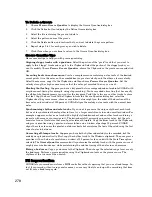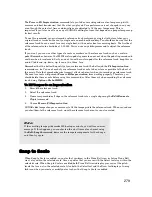
278
:
To Delete a Groove
1.
Choose
Process-Groove Quantize
to display the Groove Quantize dialog box.
2.
Click the Define button to display the Define Groove dialog box.
3.
Select the file containing the groove to delete.
4.
Select the pattern name of the groove.
5.
Click the Delete button, and confirm that you want to delete the groove pattern.
6.
Repeat steps 3 to 5 for each groove you wish to delete.
7.
Click Close when you are done to return to the Groove Quantize dialog box.
Groove Quantize Tips
Here are some tips to help you with groove quantizing:
Aligning sloppy tracks with a good one.
Select the portion of the “good” track that you want to
apply to the “sloppy” tracks and copy it to the Clipboard. Select the portion of the sloppy tracks you
want to modify. Choose
Process-Groove Quantize
, choose the Clipboard as the groove source, and click
OK.
Accenting beats in each measure.
Create a sample measure containing note events at the desired
accent points. Give the notes on the accented beats a greater velocity and the others a lesser velocity.
Select the measure, copy it to the Clipboard, and then choose
Process-Groove Quantize
. Set the
velocity strength as high as necessary so that the notes get accented the way you want.
Stealing that feeling.
Suppose you have a dry piece that was composed and entered into SONAR with
a rigid sense of timing (for example, using step recording). You’ve recorded a bass line that has exactly
the off-beat rhythmic dynamic you want for the dry piece. You’d like to force your other tracks to share
that feel. Copy the bass track to the Clipboard; from the Groove Quantize dialog box, select the
Clipboard as the groove source; choose a resolution value roughly on the order of the duration of the
bass notes and a window of 100 percent. SONAR
aligns the melody note events with the nearest bass
notes.
Synchronizing rhythm and solo tracks.
If you want to preserve the unique rhythm of each track
but want to synchronize them together in time, try a larger resolution value and a smaller window. For
example, suppose you have one track with a highly stylized drum beat and another track containing a
jazz solo with some very nice runs in it. The drum beats fall primarily on quarter notes, but the solo
consists of runs of fast notes that aren’t quite sixteenth triplets. Copy the drum track to the Clipboard,
and groove quantize using a quarter-note resolution and a window of perhaps 10 percent. SONAR
aligns the solo notes near the quarter-note drum beats but maintains the feel of the solo during the fast
runs of notes in between.
Correcting off-tempo tracks.
Suppose you have both rhythm and melody tracks recorded, but the
melody was played erratically. First, copy the rhythm track to the Windows clipboard. Then use groove
quantize with a whole-note resolution, a window of 25 percent or less, and with the Scale Time option
selected. The
Groove Quantize
command will synchronize the melody track with the groove source at
roughly measure boundaries, while maintaining the relative timing of the notes in each measure.
Fixing a bad verse.
Copy a good verse to the Clipboard. Then change the selected range to cover only
the bad verse. Perform a groove quantize using the Clipboard contents as the groove source. The
rhythms of the two verses then match.
Fit Improvisation
SONAR lets you record music from a MIDI controller without requiring that you use a fixed tempo. In
fact, if you record without using a metronome, you are very likely to end up with a recording that does
not fit onto a fixed tempo grid.
Summary of Contents for Cakewalk SONAR
Page 1: ...Cakewalk SONAR User s Guide ...
Page 2: ......
Page 4: ......
Page 22: ...xxii ...
Page 50: ...50 ...
Page 102: ...102 ...
Page 182: ...182 ...
Page 302: ...302 ...
Page 420: ...420 English ...
Page 466: ...466 ...
Page 502: ...502 ...
Page 574: ...574 ...
Page 580: ...580 ...
Page 608: ...608 ...
















































